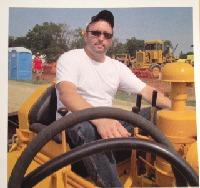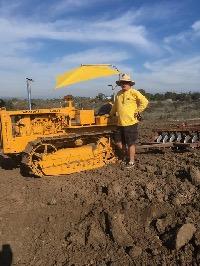-
Forum
-
Antique Caterpillar Machinery Owners Club
-
DISCUSSION
-
D2 5u main clutch
D2 5u main clutch
Less
More
-
Posts: 38
-
Thank you received: 1
-
1 month 2 days ago #259870
by n2s3
I am having to replace my main clutch for the third time, although over almost a twenty year period.the last one lasted six years. all due to stripped teeth off the clutch disk
My question is if i am abusing the old girl.Maybe asking too much of her? We live in hilly forested northern ca. Dozer is used mostly for winching Redwoods out of ravines that pg&e had fallen or winching firewood logs. Occasionally skidding logs on a fire road for only a short distance. gets used maybe a dozen times a year.
I talked to General Gear,he said to look for wear on pilot(replaced last go around) and input shaft bearing wear.
Also,getting a small amount of water in the transmission. Can't come from rain as its kept in a barn. I wanted to address this while engine is out. thanks for the help.
Please Log in or Create an account to join the conversation.
Less
More
-
Posts: 6893
-
Thank you received: 657
-
1 month 1 day ago #259879
by neil
I'd guess at runout on the coupling between the clutch spigot and the transmission input. The clutch disk should basically not move in both the engaged and disengaged positions. Put the clutch assembly in a pair of v-blocks and check it for runout, also check the input shaft, and then check the clutch output spigot when the coupling is attached. They need to be concentric
For the water in the transmission, if there's no rain ingress, then perhaps you have a condensation issue, but that would only occur if you put it away hot in a humid climate
Cheers,
Neil
Pittsford, NY
Please Log in or Create an account to join the conversation.
Less
More
-
Posts: 173
-
Thank you received: 35
-
1 month 1 day ago #259884
by clayton
Something simple to over look is remember to always have your clutch engaged, only disengage when needing to put it in gear. If you run the diesel with the clutch disengage for long periods of time it can start to shift/walk eventually stripping the teeth off just something simple to check and remember to do.
The following user(s) said Thank You:
side-seat Please Log in or Create an account to join the conversation.
Less
More
-
Posts: 520
-
Thank you received: 60
-
1 month 1 day ago #259887
by cr
In regards to the water in the transmission during storage under cover. Redwoods grow and thrive in the heavy costal fog areas, in fact the leaves are designed to capture that condensation. In costal fog you have air that is at or near its maximum capacity to hold water at the given air temperature, generally with costal fog and inland tule fog the air temperature and dew point tend to track each other. Then you have all of that cast iron gets cold at night so it’s colder than the dew point during the day and you end up with condensation forming inside of the tractor. That’s why frozen clutch packs, stuck injection racks and injection pumps become quite common in tractors found in this environment / region. Things in this environment rust from the inside out, even when stored under cover. A very famous Gold Rush writer had some choice words about that areas climate when stuck in the Mendocino Redwood sawmill region, might not be what people assume the climate is based on how it is 500 miles to the south:)
The following user(s) said Thank You:
Ray54 Please Log in or Create an account to join the conversation.
Less
More
-
Posts: 1242
-
Thank you received: 125
-
1 month 3 hours ago #259915
by Sasquatch
Idling with the clutch disengaged is the #1 cause of stripped clutch disc teeth in D2’s and D4’s, as clayton already said. When the clutch is engaged, the disc is held securely inside the flywheel teeth but in the disengaged position it’ll rattle slightly against them, similar to backlash clicking between gears. As the clutch teeth wear, the backlash increases, as does the wear rate until the teeth are gone. If you’re already not idling with the clutch disengaged, then it’s time to check for wear inside the flywheel teeth, badly warped pressure plates that could be shifting the disc inside the flywheel, or input shaft bent/worn.
The following user(s) said Thank You:
Busso20 Please Log in or Create an account to join the conversation.
Less
More
-
Posts: 38
-
Thank you received: 1
-
2 weeks 6 days ago #260095
by n2s3
thanks for the responses. heard from someone years ago about not leaving the clutch disengaged ,thanks. I will probably need some more help when I get it apart this winter and get a good look at everything.
Please Log in or Create an account to join the conversation.
Less
More
-
Posts: 6893
-
Thank you received: 657
-
2 weeks 5 days ago #260099
by neil
The other reason to keep it engaged is if the engine (either one) is running and the operator is not in the operator's seat. If the clutch is disengaged, it's not clear if the tractor is in gear or not. If the clutch is engaged before the operator gets off the machine and it's not moving, that's a fairly solid indication that it's not in gear. Not entirely foolproof but good enough for govt. work.
Cheers,
Neil
Pittsford, NY
The following user(s) said Thank You:
bernie Please Log in or Create an account to join the conversation.
Less
More
-
Posts: 318
-
Thank you received: 66
-
2 weeks 5 days ago #260101
by d4angelo
This is what happens to your clutch when it is not properly engaged. Ask me how I know. This picture shows the missing teeth.
The following user(s) said Thank You:
Busso20 Please Log in or Create an account to join the conversation.
Less
More
-
Posts: 120
-
Thank you received: 6
-
2 weeks 5 days ago #260103
by rhartwick
In addition to the above, I always thought wear on the pilot bearing was another major reason to engage the clutch while idling.
Please Log in or Create an account to join the conversation.
-
Forum
-
Antique Caterpillar Machinery Owners Club
-
DISCUSSION
-
D2 5u main clutch
Time to create page: 0.200 seconds




